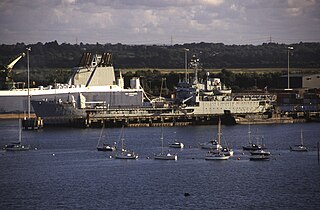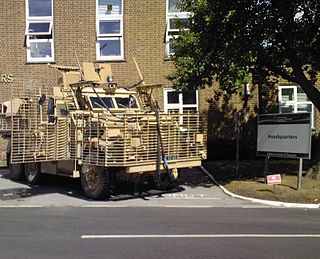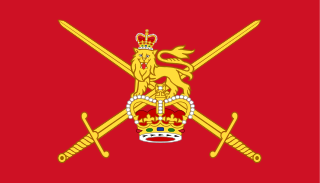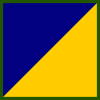
The Royal Logistic Corps provides logistic support functions to the British Army. It is the largest Corps in the Army.

The Royal Corps of Transport (RCT) was a British Army Corps established to manage all matters in relation to the transport of men and material for the Army and the wider Defence community. It was formed in 1965 and disbanded in 1993; its units and trades were amalgamated into the Royal Logistic Corps. The Depot and Training Regiment RCT was at the former Buller Barracks in Aldershot garrison.

The ramped craft logistic (RCL) is a type of landing craft operated by 17 Port and Maritime Regiment RLC of the Royal Logistic Corps of the British Army. From the early 1980s onwards it was deployed to replace the RPL. One of their first roles was to provide logistical support during the setting up of the garrison in the Falkland Islands immediately after the Falklands War - this role was conducted by the two first of class, Arromanches and Antwerp, later stationed at the military port at Marchwood, near Southampton, RCLs were originally procured for UK, Cyprus and Hong Kong. The two based at the British base at Akrotiri, Cyprus, Andalsnes and Akyab were operated as 417 Troop of 17 Port and Maritime Regiment RLC. They were sold in 2014
11 Explosive Ordnance Disposal and Search Regiment RLC is a specialist regiment of the British Army's Royal Logistic Corps (RLC) responsible for counter terrorist Explosive Ordnance Disposal (EOD), the safe recovery or disposal of conventional munitions. The regiment also has an ammunition inspectorate role supporting the Inspector Explosives (Army). With headquarters in Didcot, the regiment has sub units geographically based throughout the UK to provide a nationwide high readiness response capability in support of the police.
The modern-day 79 Railway Squadron was part of the 17 Port and Maritime Regiment, The Royal Logistic Corps, of the British Army. They were responsible for maintaining and providing the British Army with its railway transportation requirements.
154 (Scottish) Regiment is a regiment of the British Army's Royal Logistic Corps. It forms part of the Army Reserve. Its role is to provide general transport support at 'third line' for the British Army.
150 Regiment RLC is a regiment of the Royal Logistic Corps Army Reserve in the United Kingdom
152 Logistic Regiment RLC is a North Irish reserve British Army regiment of The Royal Logistic Corps.
This is the Operation Herrick ground order of battle, which lists any British ground forces that have taken part in the duration of Operation Herrick between 2002 and 2014.
156 Regiment RLC is an Army Reserve Regiment of the British Army's Royal Logistic Corps.
160 Transport Regiment Royal Logistic Corps (Volunteers), was a regiment of the Territorial Army in the United Kingdom.

Marchwood Military Port (MMP) or Marchwood Sea Mounting Centre (SMC) is a military port located in Marchwood, Southampton on the south coast of the UK, and the base of 17 Port & Maritime Regiment Royal Logistic Corps. The port was built in 1943 to aid in the D-Day assault on Normandy in 1944 and has since been used to support the Falklands War.

The Defence School of Transport (DST) Leconfield is located at Normandy Barracks, Leconfield near Beverley, East Riding of Yorkshire in England.
157 (Welsh) Regiment RLC is an Army Reserve regiment of the Royal Logistic Corps.

The Duke of Gloucester Barracks is a British Army barracks at South Cerney in Gloucestershire. The site is also home to the Joint Air Mounting Centre.
7 Regiment RLC is a regiment of the British Army's Royal Logistic Corps.

1 Regiment RLC is a regiment of the British Army's Royal Logistic Corps.

The structure of the British Army of the United Kingdom (UK) is currently being reorganised to the Future Soldier structure. Due to these reforms taking place gradually, it is likely that some areas will not be fully complete. The British Army is commanded by the Chief of the General Staff (CGS), with Army Headquarters which is located in Andover, Hampshire. Subordinate to that post, there is a Commander Field Army, and a personnel and UK operations command, Home Command.
The 2nd Division Transport Regiment was a military support unit of the British Army, forming part of the Royal Corps of Transport. Initially formed in 1953, the regiment would serve the 2nd Infantry Division until its first disbandment in 1984 following a reorganisation of the British Army of the Rhine. Reformed one year later, it would finally be disbanded in 1993 following the End of the Cold War.











